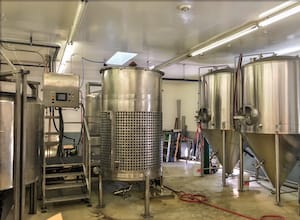Customer Profile: Alibi Ale Works

Alibi Ale Works
Incline Village, Nevada
Population: 8,777
The small town of Incline Village sits on the picturesque north shore of Lake Tahoe. During the mining boom in the late 1800s, lumber for the mines was harvested from the abundant timber supplies around Lake Tahoe. The lumber hauled up 1,400 feet on an incline railway and then dropped through a gravity flume down the western side of the mountain to Carson City.
Today, Incline Village is an extremely popular vacation destination which means that a significant portion of the population seasonal. But it is also a town of artists. Having more artists, designers and people working in media than 90% of the communities in America, artistry and craftsmanship help mold the character of the town.
As the nation experiences the new boom of craft beer, we checked in at Alibi Ale Works and spoke with co-owner and brewer Kevin Drake.
How did Alibi Ale Works get started?
I grew up in Portland, Oregon and developed a taste for craft beer early in life and moved to Lake Tahoe in 2004. Back then, the craft beer scene was pretty lame and opening a brewery had always been a dream. I met my now business partner Rich Romo in 2011. He had a varied background in commercial real estate redevelopment, marketing and photography, and most of the construction trades. He also had ambitions to open a brewery.
My skill set is more on the brewing and science side and he is the more mechanically-savvy one with all the skills to actually build a brewery so we were a good match. We did a kickstarter campaign for $35k in the Fall of 2012. We didn’t meet our goal but it turned out to be a very good thing. It forced us to take a step back, think bigger and raise a lot more capital to start a more sustainable brewing operation. After looking for a building for a year and a half, we finally found our current building and signed the lease in February 2014. It was a former auto parts store and body shop with roll up doors, 7000 square feet, 3-phase power, and appropriate zoning for manufacturing.
That is a tough combination to find in North Lake Tahoe. After doing all the build out ourselves, we opened our doors 10 months later on December 13, 2014. We currently have 9 employees and will increase to 12 in summer when our beer garden opens.
Do you distribute or mainly focus on taproom sales?
We have sold 100% of our beer through our taproom until literally last week. We are now signed on with Wirtz Beverage for distribution in NV and just sold our first kegs to a beer bar in Reno last week. We expect to be distributing in CA by March. Our plan is to keep draft beer within about 50 miles of our brewery in the near future. We will start bottling and canning in-house later this spring.
What are the brewery specs: barrel capacity, number and size of fermenters, etc.
We opened with a 5bbl brew house that we built ourselves.
- Two 10bbl fermenters
- Two 3bbl fermenters
- One 7bbl grundy tank
- One 10bbl oak fermenter (open top).
- Annual capacity of this system is about 450bbls.

By the time this posted, we will have fired up our new 15bbl, 4-vessel brew house!
- Four 30bbl unitanks
- Two additional 30bbl tanks in the near future
- Our capacity in 2016 will be at least 2,500bbls; increasing to 3,500bbl per year with the two additional tanks.
What’s the reception been like of the locals?
Amazing! Our town is known for having mostly wealthy second-home owners. But we’ve become the go-to gathering place for nearly all of the year-round residents. Incline Village has mostly sports bars and fine dining establishments. For people who want to get away from TV and gambling, we’ve become their “Cheers” bar. We seriously have regulars who come in 3-4 times a week. Despite being in a very tourist-driven area (skiing in winter, lake recreation in the summer), 60-70% of our sales in 2015 were repeat customers most of whom were local.
Were you a homebrewer and if so, what’s the biggest difference in going from homebrewing to production brewing?
When we opened I had about 17 years of homebrewing experience and my partner had about 3 years. It was a pretty easy transition to go from 15 gallon homebrew batches to 150 gallon batches on our original brew system. It is a very manual system and was basically homebrewing on a bigger scale.
We spent the first full year of the business selling everything out of the taproom and not focusing too much on developing flagship beers. That gave me a lot of freedom to brew whatever I wanted…much like homebrewing. Probably the biggest differences for me have been working with more pumps and getting to know a wider range of chemicals used in larger-scale cleaning and sanitizing. Also I’ve been starting to focus much more on repeatability and consistency as we’ve been developing a few core/year-round beers.

What is your brewing style?
We lean more toward European styles. We have tried to focus on brewing beers that are in the mid to low end of the alcohol range (say 4-6% abv) that are well-attenuated and highly pintable. We make a rotating selection of IPAs, but we’re not a super hop-focused brewery. We do love well made hoppy beers, but we’re trying to stay out of the IPA arms race (though we did just brew a huge triple IPA for our anniversary).
Our three core beers are an English-style porter, a very sessionable saison, and a hoppy American pale ale. Other favorites have been our dark strong saison, kolsch, altbier, berlinerweisse, imperial stout and scotch ale.
We also keep a rotating selection of tart/funky/sour beers on tap. Many of these go through primary fermentation in our 10bbl oak fermenter with our house mixed culture. We’ve been able to turn out some really complex tart/sour beers with a few months turnaround time. Others have been aging in wine barrels for over a year now. We are experimenting a lot right now and are constantly trying to improve and expand our sour program.
We are sticking with the beer style names for now. In part because it’s hard to come up with beer names that aren’t already being used and in part because we think it’s kind of refreshing to just call the beer what it is and let it speak for itself.
We like to say that an Alibi is a story that checks out. Unfortunately, there are a lot of smoke and mirrors in beer these days and we’re trying to be authentic and real. We think craft beer drinkers need an Alibi….a story that checks out.
How has your experience been working with RahrBSG?
We love RahrBSG. You have been our only grain provider for our first year of operation. When we were starting up, our sales rep Peter Hoey was a great mentor to me when I called him with questions. I should also give a shout out to customer service rep Michael Obermire who is always helpful with ordering and logistics.
What’s next on the horizon?
Right now we’re focused on getting our 15bbl brewhouse up and running and growing into the fermentation capacity we have in place. We’re adding a hybrid bottling and canning line in about a month and I’m looking forward to ramping up our lab/QC program as we begin packaging our beers.